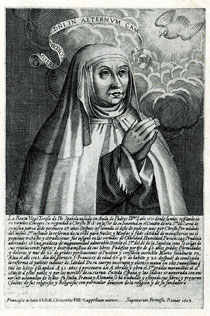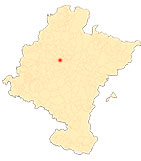pathway Teresian in Pamplona
An early engraving of the saint made in Rome in 1603.
In the cloister of the Discalced Carmelites of San José, an important collection of engraved prints is preserved, acquired by Leonor de la Misericordia (Ayanz y Beaumont), whose facsimile we published in 2004. All of them were bound and numbered in the 17th century, after their acquisition by the aforementioned Carmelite, in the last years of the 16th century. Leonor's fondness for engraved images led her to illustrate the manuscript copies of one of her works, the Life of Catalina de Cristo, foundress of Soria, Pamplona and Barcelona, with ad hoc engravings, in relation to the subjects of the different chapters. Leonor had acquired in her youth an exquisite humanist training with Doña Brianda de Beaumont, daughter and heiress of the Constable of Navarre, remembered by Lope de Vega in La Arcadia (1598), as "the divine Doña Brianda, glory of Beaumonte".
Particularly interesting for the Carmel of Pamplona and the city is the engraving that represents Mother Teresa of Jesus, according to the models popularized in her first prints, which closely follow the portrait that Fray Juan de la Miseria made of her in 1576. It repeats the praying model with joined hands, contemplating the Paraclete, accompanied by a phylactery where we read the well-known phrase: MISERICORDIAS DOMINI IN AETERNUM CANTABO. We know the generous patron of the engraving, who is none other than the one who also had the plate of Catalina de Cristo opened in 1603 in Rome. He is Don Francisco de Soto, a priest from Soria, first soprano and Dean, for many years, of the Sistine Chapel, chaplain of Clement VIII, who in 1597 founded in the Eternal City the first convent of Discalced Carmelites. An inordinate registration gives us an account of the main events of his life. The purpose of the print was, without a doubt, postulatory, at a time when the processes of beatification were in full swing, since they were opened in Salamanca in 1591.
-
FERNÁNDEZ GRACIA, R., "El convento e iglesia de los Carmelitas Descalzos de Pamplona. Architecture", Príncipe de Viana, 164, 1981, pp. 787-818.
-
ECHEVERRÍA GOÑI, P. and FERNÁNDEZ GRACIA, R., "El convento e iglesia de los carmelitas descalzos de Pamplona. Exorno artístico", Príncipe de Viana, 164, 1981, pp. 819-891.
-
AZANZA LÓPEZ, J. J., Arquitectura Religiosa Barroca en Navarra, Pamplona, Government of Navarre, 1996.
-
FERNÁNDEZ GRACIA, R., El retablo barroco en Navarra, Pamplona, Government of Navarre, 2003.
-
FERNÁNDEZ GRACIA, R., The Immaculate Conception in Navarre. Art and devotion during the centuries of the Baroque Mentors, artists and iconography. Pamplona, Eunsa, 2004.
-
FERNÁNDEZ GRACIA, R., Engraving, Counter-Reformation and Teresian Carmel. The collection of engravings of the Discalced Carmelites of Pamplona and Leonor de la Misericordia (Ayanz and Beaumont). Pamplona, I. G. Castuera, 2004.
-
FERNÁNDEZ GRACIA, R., "Santa Teresa", Juan de Goyeneche y el triunfo de los navarros en la Monarquía Hispánica del siglo XVIII, Pamplona, Fundación Caja Navarra, 2005, p. 352.
-
FERNÁNDEZ GRACIA, R., "Algunas esculturas napolitanas en Navarra", Pulchrum. Scripta in honorem Mª Concepción García Gainza, Pamplona, Government of Navarre, department de Cultura y Turismo-Institución Príncipe de Viana, 2011, pp. 300-310.
-
TARIFA CASTILLA, M. J., "Aparición de Cristo a Santa Teresa", Pamplona y San Cernin 1611-2011. IV Centenary of the Vow of the City, Pamplona, Pamplona City Council, 2011, p. 176.












